Financial Markets, the 2008 Crisis, and Banking Crisis Recommendations
VerifiedAdded on 2023/06/18
|8
|2560
|262
Report
AI Summary
This report examines the influence of financial markets on economic activity in the 21st century, particularly focusing on the 2008 financial crisis and its causes, such as deregulation and the rise in mortgage-backed securities. It discusses recommendations for preventing future banking crises, including stricter bank regulations, reduced dependency on the US financial sector, improved consumer literacy, and the elimination of liquidity requirements. The report also delves into the costs and impact of R&D in the pharmaceutical industry, highlighting how R&D has affected the industry's structure, including the acquisition of smaller firms by larger ones for innovation, and the challenges in developing vaccines, particularly concerning intellectual property rights and collaboration between firms.

Report
1
1
Paraphrase This Document
Need a fresh take? Get an instant paraphrase of this document with our AI Paraphraser
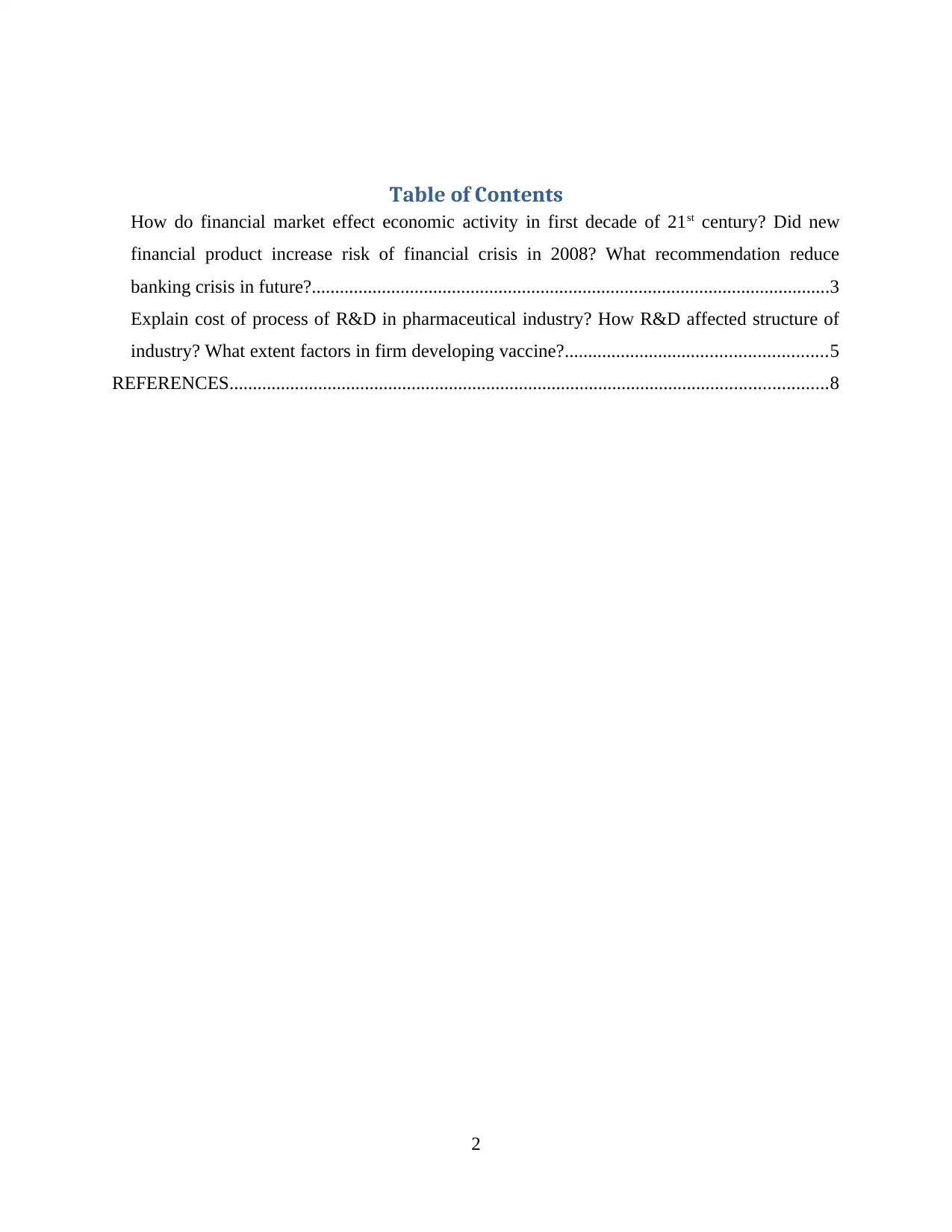
Table of Contents
How do financial market effect economic activity in first decade of 21st century? Did new
financial product increase risk of financial crisis in 2008? What recommendation reduce
banking crisis in future?...............................................................................................................3
Explain cost of process of R&D in pharmaceutical industry? How R&D affected structure of
industry? What extent factors in firm developing vaccine?........................................................5
REFERENCES................................................................................................................................8
2
How do financial market effect economic activity in first decade of 21st century? Did new
financial product increase risk of financial crisis in 2008? What recommendation reduce
banking crisis in future?...............................................................................................................3
Explain cost of process of R&D in pharmaceutical industry? How R&D affected structure of
industry? What extent factors in firm developing vaccine?........................................................5
REFERENCES................................................................................................................................8
2
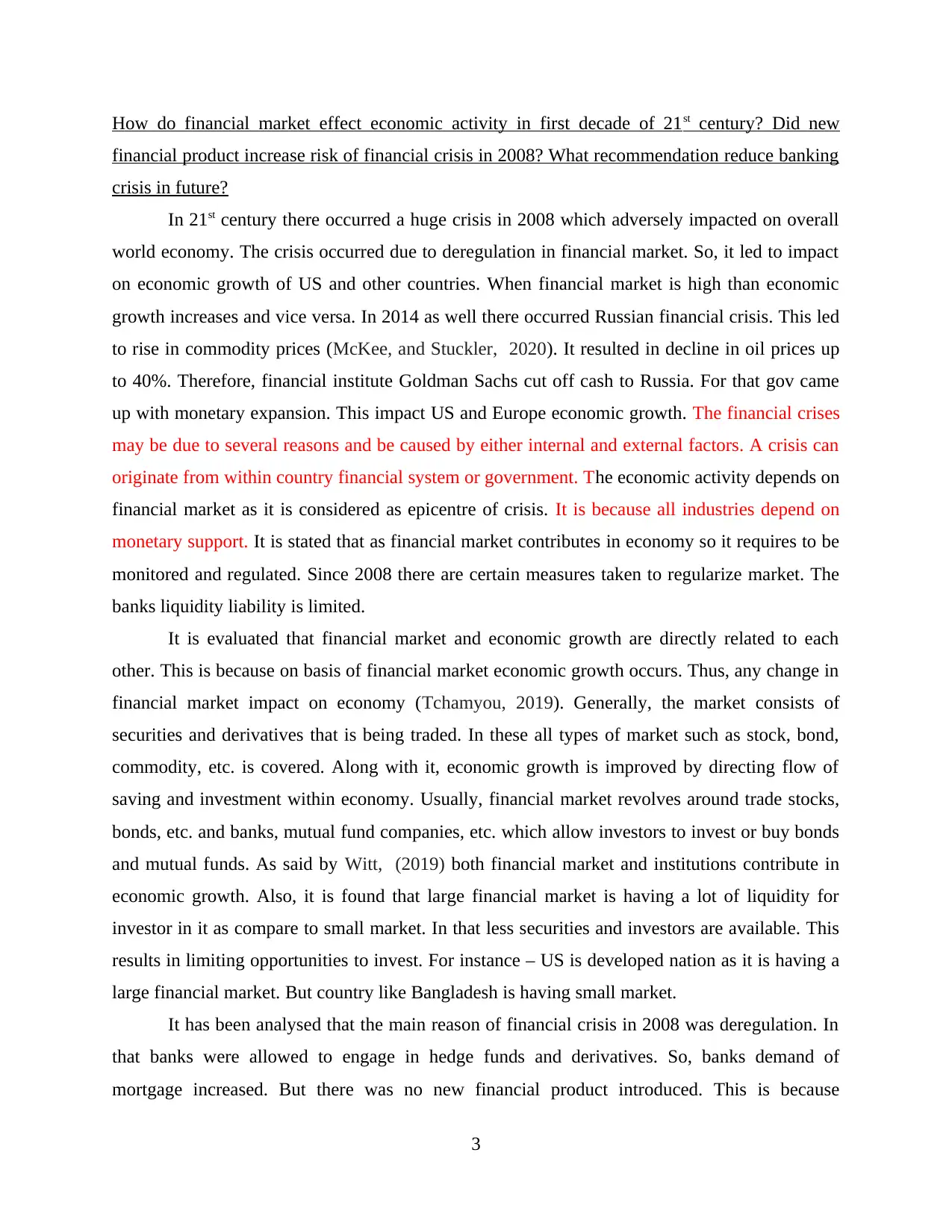
How do financial market effect economic activity in first decade of 21st century? Did new
financial product increase risk of financial crisis in 2008? What recommendation reduce banking
crisis in future?
In 21st century there occurred a huge crisis in 2008 which adversely impacted on overall
world economy. The crisis occurred due to deregulation in financial market. So, it led to impact
on economic growth of US and other countries. When financial market is high than economic
growth increases and vice versa. In 2014 as well there occurred Russian financial crisis. This led
to rise in commodity prices (McKee, and Stuckler, 2020). It resulted in decline in oil prices up
to 40%. Therefore, financial institute Goldman Sachs cut off cash to Russia. For that gov came
up with monetary expansion. This impact US and Europe economic growth. The financial crises
may be due to several reasons and be caused by either internal and external factors. A crisis can
originate from within country financial system or government. The economic activity depends on
financial market as it is considered as epicentre of crisis. It is because all industries depend on
monetary support. It is stated that as financial market contributes in economy so it requires to be
monitored and regulated. Since 2008 there are certain measures taken to regularize market. The
banks liquidity liability is limited.
It is evaluated that financial market and economic growth are directly related to each
other. This is because on basis of financial market economic growth occurs. Thus, any change in
financial market impact on economy (Tchamyou, 2019). Generally, the market consists of
securities and derivatives that is being traded. In these all types of market such as stock, bond,
commodity, etc. is covered. Along with it, economic growth is improved by directing flow of
saving and investment within economy. Usually, financial market revolves around trade stocks,
bonds, etc. and banks, mutual fund companies, etc. which allow investors to invest or buy bonds
and mutual funds. As said by Witt, (2019) both financial market and institutions contribute in
economic growth. Also, it is found that large financial market is having a lot of liquidity for
investor in it as compare to small market. In that less securities and investors are available. This
results in limiting opportunities to invest. For instance – US is developed nation as it is having a
large financial market. But country like Bangladesh is having small market.
It has been analysed that the main reason of financial crisis in 2008 was deregulation. In
that banks were allowed to engage in hedge funds and derivatives. So, banks demand of
mortgage increased. But there was no new financial product introduced. This is because
3
financial product increase risk of financial crisis in 2008? What recommendation reduce banking
crisis in future?
In 21st century there occurred a huge crisis in 2008 which adversely impacted on overall
world economy. The crisis occurred due to deregulation in financial market. So, it led to impact
on economic growth of US and other countries. When financial market is high than economic
growth increases and vice versa. In 2014 as well there occurred Russian financial crisis. This led
to rise in commodity prices (McKee, and Stuckler, 2020). It resulted in decline in oil prices up
to 40%. Therefore, financial institute Goldman Sachs cut off cash to Russia. For that gov came
up with monetary expansion. This impact US and Europe economic growth. The financial crises
may be due to several reasons and be caused by either internal and external factors. A crisis can
originate from within country financial system or government. The economic activity depends on
financial market as it is considered as epicentre of crisis. It is because all industries depend on
monetary support. It is stated that as financial market contributes in economy so it requires to be
monitored and regulated. Since 2008 there are certain measures taken to regularize market. The
banks liquidity liability is limited.
It is evaluated that financial market and economic growth are directly related to each
other. This is because on basis of financial market economic growth occurs. Thus, any change in
financial market impact on economy (Tchamyou, 2019). Generally, the market consists of
securities and derivatives that is being traded. In these all types of market such as stock, bond,
commodity, etc. is covered. Along with it, economic growth is improved by directing flow of
saving and investment within economy. Usually, financial market revolves around trade stocks,
bonds, etc. and banks, mutual fund companies, etc. which allow investors to invest or buy bonds
and mutual funds. As said by Witt, (2019) both financial market and institutions contribute in
economic growth. Also, it is found that large financial market is having a lot of liquidity for
investor in it as compare to small market. In that less securities and investors are available. This
results in limiting opportunities to invest. For instance – US is developed nation as it is having a
large financial market. But country like Bangladesh is having small market.
It has been analysed that the main reason of financial crisis in 2008 was deregulation. In
that banks were allowed to engage in hedge funds and derivatives. So, banks demand of
mortgage increased. But there was no new financial product introduced. This is because
3
⊘ This is a preview!⊘
Do you want full access?
Subscribe today to unlock all pages.

Trusted by 1+ million students worldwide
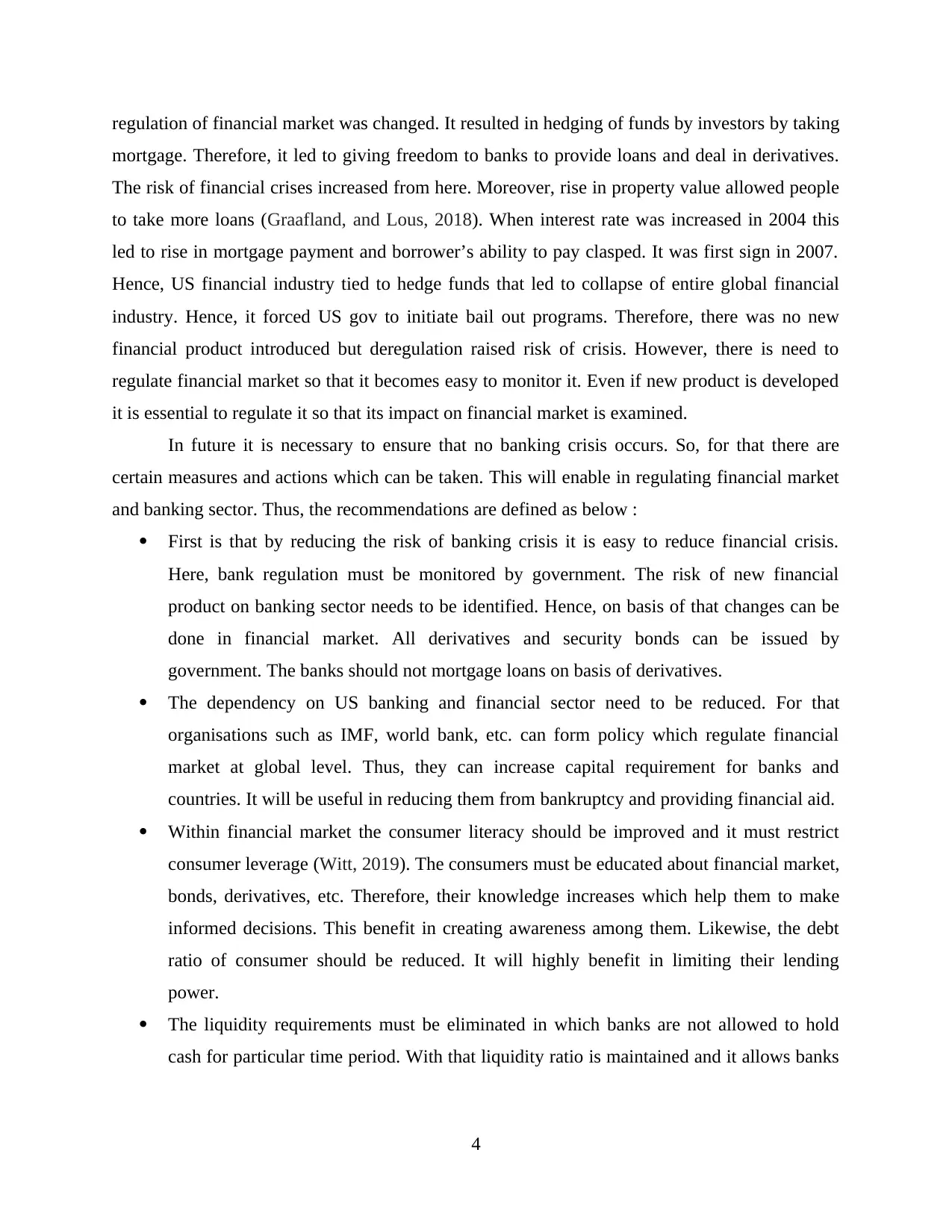
regulation of financial market was changed. It resulted in hedging of funds by investors by taking
mortgage. Therefore, it led to giving freedom to banks to provide loans and deal in derivatives.
The risk of financial crises increased from here. Moreover, rise in property value allowed people
to take more loans (Graafland, and Lous, 2018). When interest rate was increased in 2004 this
led to rise in mortgage payment and borrower’s ability to pay clasped. It was first sign in 2007.
Hence, US financial industry tied to hedge funds that led to collapse of entire global financial
industry. Hence, it forced US gov to initiate bail out programs. Therefore, there was no new
financial product introduced but deregulation raised risk of crisis. However, there is need to
regulate financial market so that it becomes easy to monitor it. Even if new product is developed
it is essential to regulate it so that its impact on financial market is examined.
In future it is necessary to ensure that no banking crisis occurs. So, for that there are
certain measures and actions which can be taken. This will enable in regulating financial market
and banking sector. Thus, the recommendations are defined as below :
First is that by reducing the risk of banking crisis it is easy to reduce financial crisis.
Here, bank regulation must be monitored by government. The risk of new financial
product on banking sector needs to be identified. Hence, on basis of that changes can be
done in financial market. All derivatives and security bonds can be issued by
government. The banks should not mortgage loans on basis of derivatives.
The dependency on US banking and financial sector need to be reduced. For that
organisations such as IMF, world bank, etc. can form policy which regulate financial
market at global level. Thus, they can increase capital requirement for banks and
countries. It will be useful in reducing them from bankruptcy and providing financial aid.
Within financial market the consumer literacy should be improved and it must restrict
consumer leverage (Witt, 2019). The consumers must be educated about financial market,
bonds, derivatives, etc. Therefore, their knowledge increases which help them to make
informed decisions. This benefit in creating awareness among them. Likewise, the debt
ratio of consumer should be reduced. It will highly benefit in limiting their lending
power.
The liquidity requirements must be eliminated in which banks are not allowed to hold
cash for particular time period. With that liquidity ratio is maintained and it allows banks
4
mortgage. Therefore, it led to giving freedom to banks to provide loans and deal in derivatives.
The risk of financial crises increased from here. Moreover, rise in property value allowed people
to take more loans (Graafland, and Lous, 2018). When interest rate was increased in 2004 this
led to rise in mortgage payment and borrower’s ability to pay clasped. It was first sign in 2007.
Hence, US financial industry tied to hedge funds that led to collapse of entire global financial
industry. Hence, it forced US gov to initiate bail out programs. Therefore, there was no new
financial product introduced but deregulation raised risk of crisis. However, there is need to
regulate financial market so that it becomes easy to monitor it. Even if new product is developed
it is essential to regulate it so that its impact on financial market is examined.
In future it is necessary to ensure that no banking crisis occurs. So, for that there are
certain measures and actions which can be taken. This will enable in regulating financial market
and banking sector. Thus, the recommendations are defined as below :
First is that by reducing the risk of banking crisis it is easy to reduce financial crisis.
Here, bank regulation must be monitored by government. The risk of new financial
product on banking sector needs to be identified. Hence, on basis of that changes can be
done in financial market. All derivatives and security bonds can be issued by
government. The banks should not mortgage loans on basis of derivatives.
The dependency on US banking and financial sector need to be reduced. For that
organisations such as IMF, world bank, etc. can form policy which regulate financial
market at global level. Thus, they can increase capital requirement for banks and
countries. It will be useful in reducing them from bankruptcy and providing financial aid.
Within financial market the consumer literacy should be improved and it must restrict
consumer leverage (Witt, 2019). The consumers must be educated about financial market,
bonds, derivatives, etc. Therefore, their knowledge increases which help them to make
informed decisions. This benefit in creating awareness among them. Likewise, the debt
ratio of consumer should be reduced. It will highly benefit in limiting their lending
power.
The liquidity requirements must be eliminated in which banks are not allowed to hold
cash for particular time period. With that liquidity ratio is maintained and it allows banks
4
Paraphrase This Document
Need a fresh take? Get an instant paraphrase of this document with our AI Paraphraser
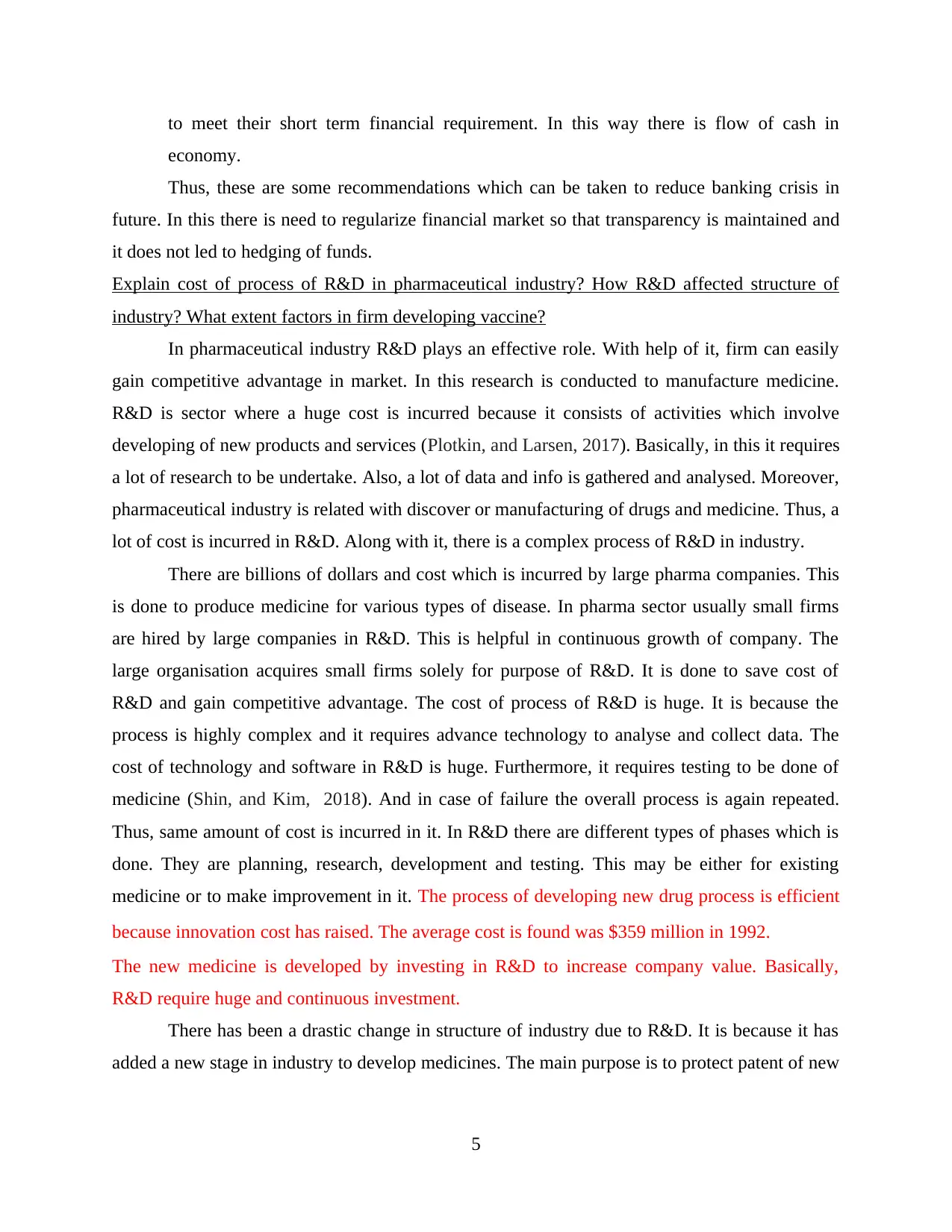
to meet their short term financial requirement. In this way there is flow of cash in
economy.
Thus, these are some recommendations which can be taken to reduce banking crisis in
future. In this there is need to regularize financial market so that transparency is maintained and
it does not led to hedging of funds.
Explain cost of process of R&D in pharmaceutical industry? How R&D affected structure of
industry? What extent factors in firm developing vaccine?
In pharmaceutical industry R&D plays an effective role. With help of it, firm can easily
gain competitive advantage in market. In this research is conducted to manufacture medicine.
R&D is sector where a huge cost is incurred because it consists of activities which involve
developing of new products and services (Plotkin, and Larsen, 2017). Basically, in this it requires
a lot of research to be undertake. Also, a lot of data and info is gathered and analysed. Moreover,
pharmaceutical industry is related with discover or manufacturing of drugs and medicine. Thus, a
lot of cost is incurred in R&D. Along with it, there is a complex process of R&D in industry.
There are billions of dollars and cost which is incurred by large pharma companies. This
is done to produce medicine for various types of disease. In pharma sector usually small firms
are hired by large companies in R&D. This is helpful in continuous growth of company. The
large organisation acquires small firms solely for purpose of R&D. It is done to save cost of
R&D and gain competitive advantage. The cost of process of R&D is huge. It is because the
process is highly complex and it requires advance technology to analyse and collect data. The
cost of technology and software in R&D is huge. Furthermore, it requires testing to be done of
medicine (Shin, and Kim, 2018). And in case of failure the overall process is again repeated.
Thus, same amount of cost is incurred in it. In R&D there are different types of phases which is
done. They are planning, research, development and testing. This may be either for existing
medicine or to make improvement in it. The process of developing new drug process is efficient
because innovation cost has raised. The average cost is found was $359 million in 1992.
The new medicine is developed by investing in R&D to increase company value. Basically,
R&D require huge and continuous investment.
There has been a drastic change in structure of industry due to R&D. It is because it has
added a new stage in industry to develop medicines. The main purpose is to protect patent of new
5
economy.
Thus, these are some recommendations which can be taken to reduce banking crisis in
future. In this there is need to regularize financial market so that transparency is maintained and
it does not led to hedging of funds.
Explain cost of process of R&D in pharmaceutical industry? How R&D affected structure of
industry? What extent factors in firm developing vaccine?
In pharmaceutical industry R&D plays an effective role. With help of it, firm can easily
gain competitive advantage in market. In this research is conducted to manufacture medicine.
R&D is sector where a huge cost is incurred because it consists of activities which involve
developing of new products and services (Plotkin, and Larsen, 2017). Basically, in this it requires
a lot of research to be undertake. Also, a lot of data and info is gathered and analysed. Moreover,
pharmaceutical industry is related with discover or manufacturing of drugs and medicine. Thus, a
lot of cost is incurred in R&D. Along with it, there is a complex process of R&D in industry.
There are billions of dollars and cost which is incurred by large pharma companies. This
is done to produce medicine for various types of disease. In pharma sector usually small firms
are hired by large companies in R&D. This is helpful in continuous growth of company. The
large organisation acquires small firms solely for purpose of R&D. It is done to save cost of
R&D and gain competitive advantage. The cost of process of R&D is huge. It is because the
process is highly complex and it requires advance technology to analyse and collect data. The
cost of technology and software in R&D is huge. Furthermore, it requires testing to be done of
medicine (Shin, and Kim, 2018). And in case of failure the overall process is again repeated.
Thus, same amount of cost is incurred in it. In R&D there are different types of phases which is
done. They are planning, research, development and testing. This may be either for existing
medicine or to make improvement in it. The process of developing new drug process is efficient
because innovation cost has raised. The average cost is found was $359 million in 1992.
The new medicine is developed by investing in R&D to increase company value. Basically,
R&D require huge and continuous investment.
There has been a drastic change in structure of industry due to R&D. It is because it has
added a new stage in industry to develop medicines. The main purpose is to protect patent of new
5
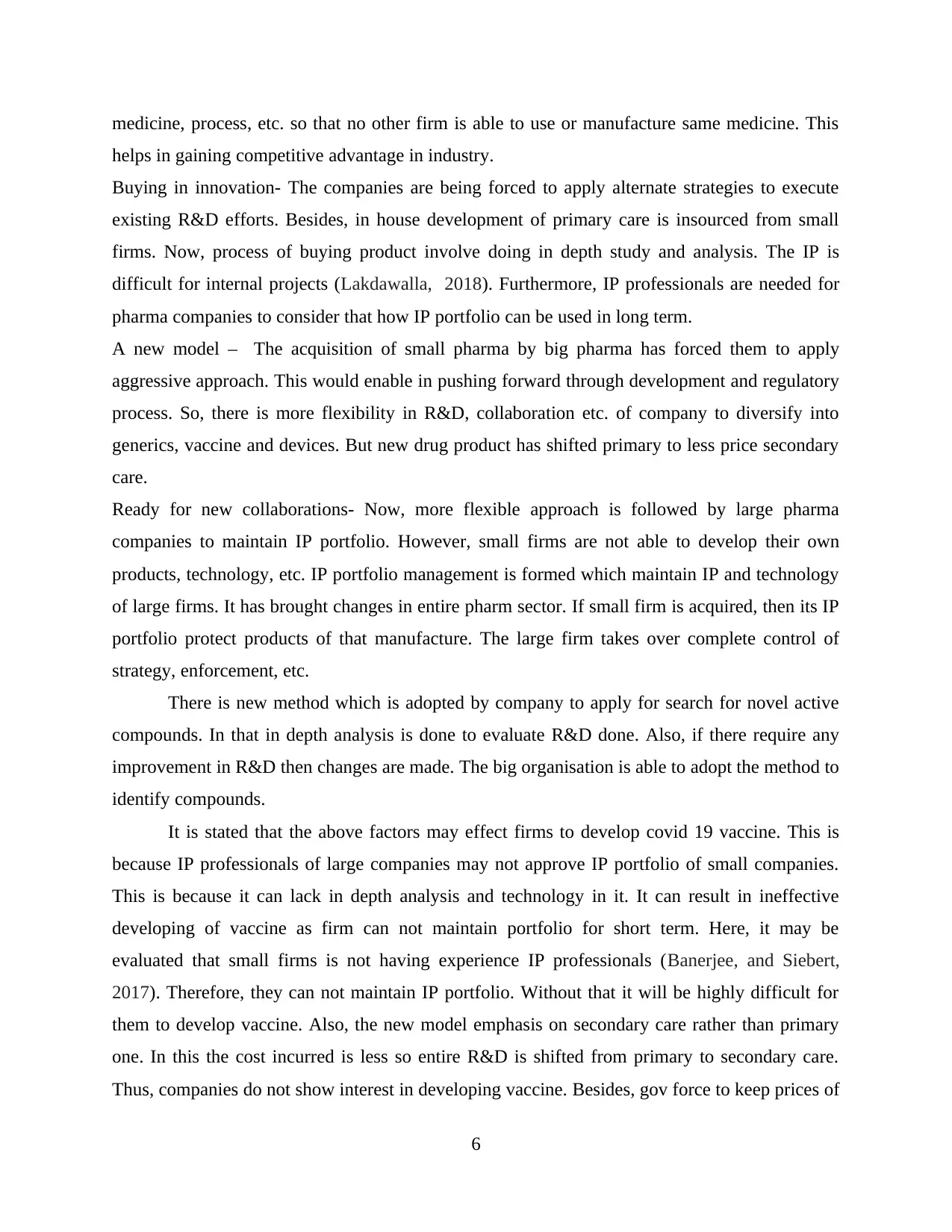
medicine, process, etc. so that no other firm is able to use or manufacture same medicine. This
helps in gaining competitive advantage in industry.
Buying in innovation- The companies are being forced to apply alternate strategies to execute
existing R&D efforts. Besides, in house development of primary care is insourced from small
firms. Now, process of buying product involve doing in depth study and analysis. The IP is
difficult for internal projects (Lakdawalla, 2018). Furthermore, IP professionals are needed for
pharma companies to consider that how IP portfolio can be used in long term.
A new model – The acquisition of small pharma by big pharma has forced them to apply
aggressive approach. This would enable in pushing forward through development and regulatory
process. So, there is more flexibility in R&D, collaboration etc. of company to diversify into
generics, vaccine and devices. But new drug product has shifted primary to less price secondary
care.
Ready for new collaborations- Now, more flexible approach is followed by large pharma
companies to maintain IP portfolio. However, small firms are not able to develop their own
products, technology, etc. IP portfolio management is formed which maintain IP and technology
of large firms. It has brought changes in entire pharm sector. If small firm is acquired, then its IP
portfolio protect products of that manufacture. The large firm takes over complete control of
strategy, enforcement, etc.
There is new method which is adopted by company to apply for search for novel active
compounds. In that in depth analysis is done to evaluate R&D done. Also, if there require any
improvement in R&D then changes are made. The big organisation is able to adopt the method to
identify compounds.
It is stated that the above factors may effect firms to develop covid 19 vaccine. This is
because IP professionals of large companies may not approve IP portfolio of small companies.
This is because it can lack in depth analysis and technology in it. It can result in ineffective
developing of vaccine as firm can not maintain portfolio for short term. Here, it may be
evaluated that small firms is not having experience IP professionals (Banerjee, and Siebert,
2017). Therefore, they can not maintain IP portfolio. Without that it will be highly difficult for
them to develop vaccine. Also, the new model emphasis on secondary care rather than primary
one. In this the cost incurred is less so entire R&D is shifted from primary to secondary care.
Thus, companies do not show interest in developing vaccine. Besides, gov force to keep prices of
6
helps in gaining competitive advantage in industry.
Buying in innovation- The companies are being forced to apply alternate strategies to execute
existing R&D efforts. Besides, in house development of primary care is insourced from small
firms. Now, process of buying product involve doing in depth study and analysis. The IP is
difficult for internal projects (Lakdawalla, 2018). Furthermore, IP professionals are needed for
pharma companies to consider that how IP portfolio can be used in long term.
A new model – The acquisition of small pharma by big pharma has forced them to apply
aggressive approach. This would enable in pushing forward through development and regulatory
process. So, there is more flexibility in R&D, collaboration etc. of company to diversify into
generics, vaccine and devices. But new drug product has shifted primary to less price secondary
care.
Ready for new collaborations- Now, more flexible approach is followed by large pharma
companies to maintain IP portfolio. However, small firms are not able to develop their own
products, technology, etc. IP portfolio management is formed which maintain IP and technology
of large firms. It has brought changes in entire pharm sector. If small firm is acquired, then its IP
portfolio protect products of that manufacture. The large firm takes over complete control of
strategy, enforcement, etc.
There is new method which is adopted by company to apply for search for novel active
compounds. In that in depth analysis is done to evaluate R&D done. Also, if there require any
improvement in R&D then changes are made. The big organisation is able to adopt the method to
identify compounds.
It is stated that the above factors may effect firms to develop covid 19 vaccine. This is
because IP professionals of large companies may not approve IP portfolio of small companies.
This is because it can lack in depth analysis and technology in it. It can result in ineffective
developing of vaccine as firm can not maintain portfolio for short term. Here, it may be
evaluated that small firms is not having experience IP professionals (Banerjee, and Siebert,
2017). Therefore, they can not maintain IP portfolio. Without that it will be highly difficult for
them to develop vaccine. Also, the new model emphasis on secondary care rather than primary
one. In this the cost incurred is less so entire R&D is shifted from primary to secondary care.
Thus, companies do not show interest in developing vaccine. Besides, gov force to keep prices of
6
⊘ This is a preview!⊘
Do you want full access?
Subscribe today to unlock all pages.

Trusted by 1+ million students worldwide
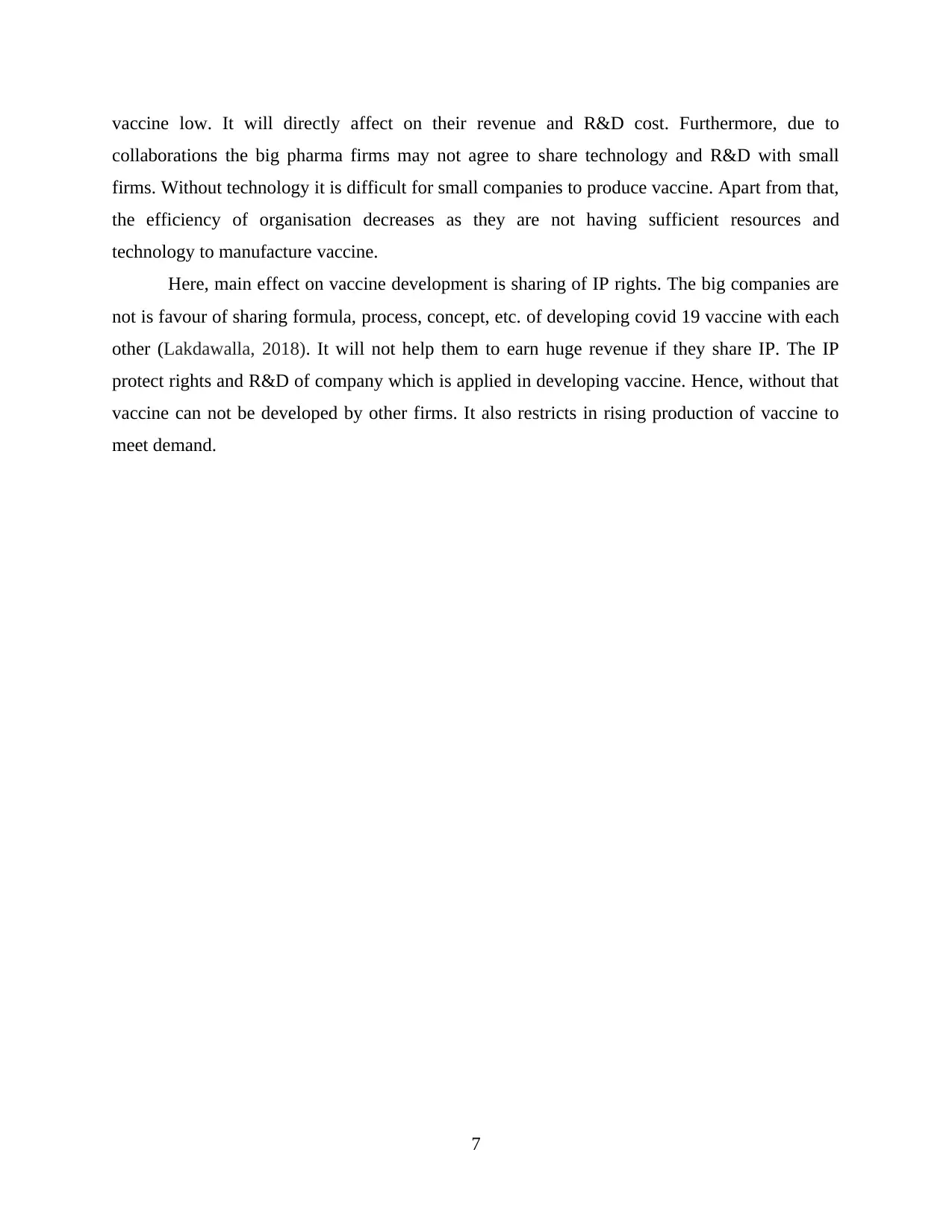
vaccine low. It will directly affect on their revenue and R&D cost. Furthermore, due to
collaborations the big pharma firms may not agree to share technology and R&D with small
firms. Without technology it is difficult for small companies to produce vaccine. Apart from that,
the efficiency of organisation decreases as they are not having sufficient resources and
technology to manufacture vaccine.
Here, main effect on vaccine development is sharing of IP rights. The big companies are
not is favour of sharing formula, process, concept, etc. of developing covid 19 vaccine with each
other (Lakdawalla, 2018). It will not help them to earn huge revenue if they share IP. The IP
protect rights and R&D of company which is applied in developing vaccine. Hence, without that
vaccine can not be developed by other firms. It also restricts in rising production of vaccine to
meet demand.
7
collaborations the big pharma firms may not agree to share technology and R&D with small
firms. Without technology it is difficult for small companies to produce vaccine. Apart from that,
the efficiency of organisation decreases as they are not having sufficient resources and
technology to manufacture vaccine.
Here, main effect on vaccine development is sharing of IP rights. The big companies are
not is favour of sharing formula, process, concept, etc. of developing covid 19 vaccine with each
other (Lakdawalla, 2018). It will not help them to earn huge revenue if they share IP. The IP
protect rights and R&D of company which is applied in developing vaccine. Hence, without that
vaccine can not be developed by other firms. It also restricts in rising production of vaccine to
meet demand.
7
Paraphrase This Document
Need a fresh take? Get an instant paraphrase of this document with our AI Paraphraser
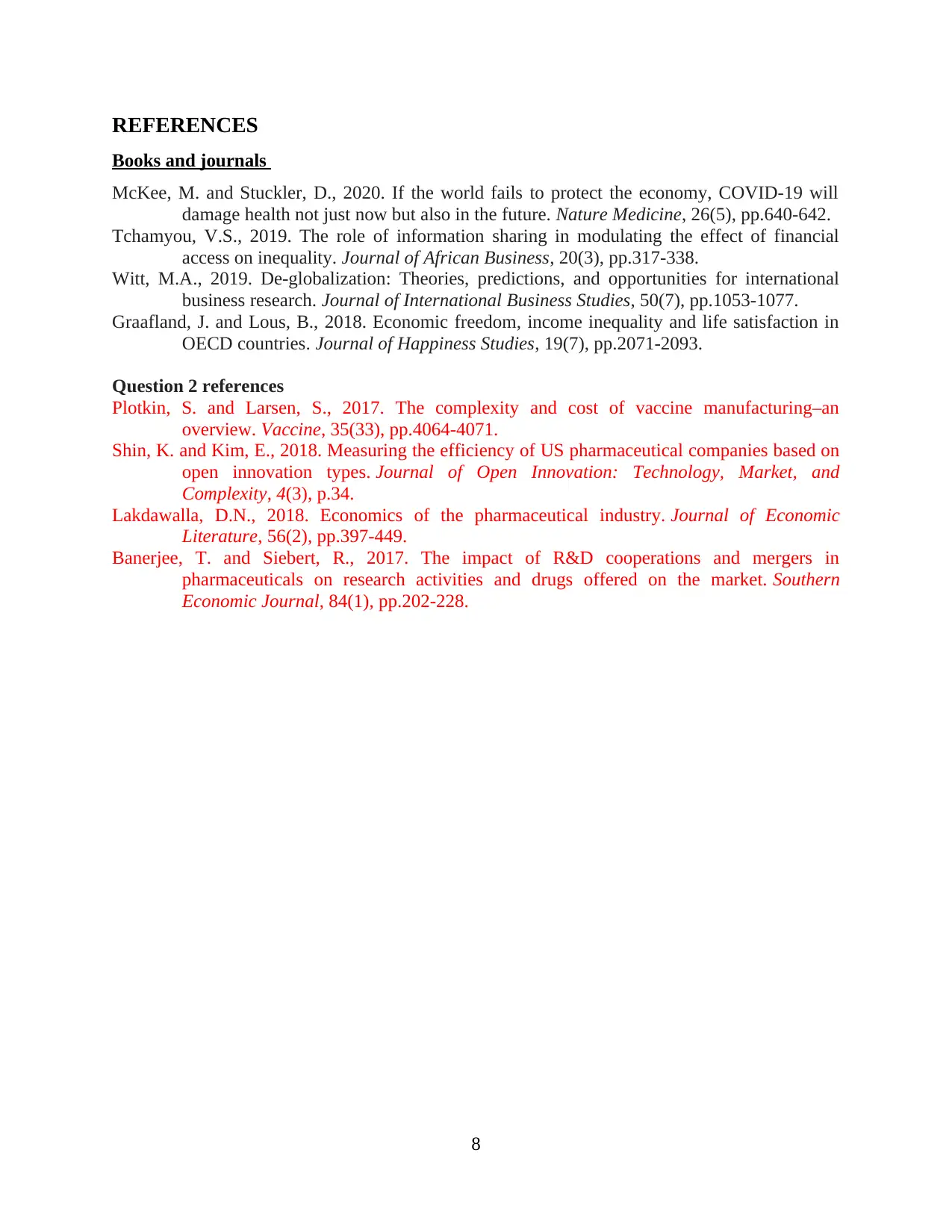
REFERENCES
Books and journals
McKee, M. and Stuckler, D., 2020. If the world fails to protect the economy, COVID-19 will
damage health not just now but also in the future. Nature Medicine, 26(5), pp.640-642.
Tchamyou, V.S., 2019. The role of information sharing in modulating the effect of financial
access on inequality. Journal of African Business, 20(3), pp.317-338.
Witt, M.A., 2019. De-globalization: Theories, predictions, and opportunities for international
business research. Journal of International Business Studies, 50(7), pp.1053-1077.
Graafland, J. and Lous, B., 2018. Economic freedom, income inequality and life satisfaction in
OECD countries. Journal of Happiness Studies, 19(7), pp.2071-2093.
Question 2 references
Plotkin, S. and Larsen, S., 2017. The complexity and cost of vaccine manufacturing–an
overview. Vaccine, 35(33), pp.4064-4071.
Shin, K. and Kim, E., 2018. Measuring the efficiency of US pharmaceutical companies based on
open innovation types. Journal of Open Innovation: Technology, Market, and
Complexity, 4(3), p.34.
Lakdawalla, D.N., 2018. Economics of the pharmaceutical industry. Journal of Economic
Literature, 56(2), pp.397-449.
Banerjee, T. and Siebert, R., 2017. The impact of R&D cooperations and mergers in
pharmaceuticals on research activities and drugs offered on the market. Southern
Economic Journal, 84(1), pp.202-228.
8
Books and journals
McKee, M. and Stuckler, D., 2020. If the world fails to protect the economy, COVID-19 will
damage health not just now but also in the future. Nature Medicine, 26(5), pp.640-642.
Tchamyou, V.S., 2019. The role of information sharing in modulating the effect of financial
access on inequality. Journal of African Business, 20(3), pp.317-338.
Witt, M.A., 2019. De-globalization: Theories, predictions, and opportunities for international
business research. Journal of International Business Studies, 50(7), pp.1053-1077.
Graafland, J. and Lous, B., 2018. Economic freedom, income inequality and life satisfaction in
OECD countries. Journal of Happiness Studies, 19(7), pp.2071-2093.
Question 2 references
Plotkin, S. and Larsen, S., 2017. The complexity and cost of vaccine manufacturing–an
overview. Vaccine, 35(33), pp.4064-4071.
Shin, K. and Kim, E., 2018. Measuring the efficiency of US pharmaceutical companies based on
open innovation types. Journal of Open Innovation: Technology, Market, and
Complexity, 4(3), p.34.
Lakdawalla, D.N., 2018. Economics of the pharmaceutical industry. Journal of Economic
Literature, 56(2), pp.397-449.
Banerjee, T. and Siebert, R., 2017. The impact of R&D cooperations and mergers in
pharmaceuticals on research activities and drugs offered on the market. Southern
Economic Journal, 84(1), pp.202-228.
8
1 out of 8
Related Documents
Your All-in-One AI-Powered Toolkit for Academic Success.
+13062052269
info@desklib.com
Available 24*7 on WhatsApp / Email
![[object Object]](/_next/static/media/star-bottom.7253800d.svg)
Unlock your academic potential
Copyright © 2020–2025 A2Z Services. All Rights Reserved. Developed and managed by ZUCOL.




